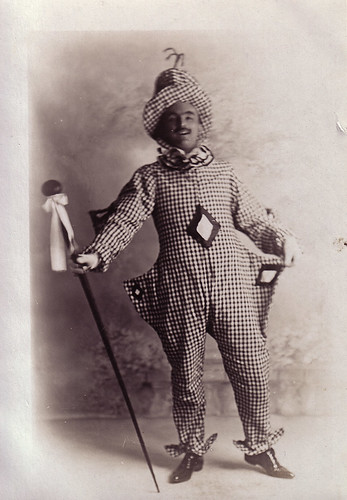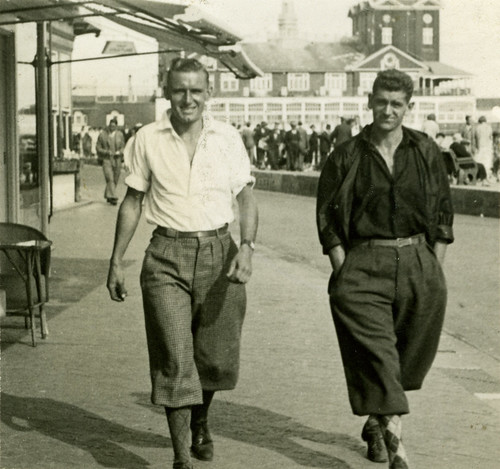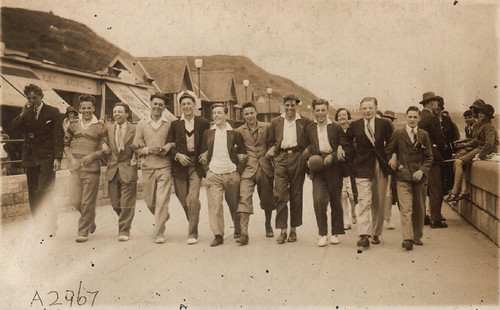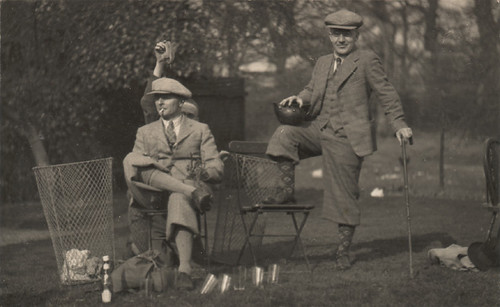Finding historic accounts of men's fashions can be a challenge. For the most part, women's fashions dominate surviving records for obvious reasons: fashion has long been assumed to be a largely feminine preoccupation, women's fashions have a faster turnover of trends so there's always some new novelty to observe, and they tend to be more dramatic and eye-catching. Equally, while a woman's appearance was (and frequently still is, sadly) considered to be the most pertinent and interesting aspect of her being, a man's appearance was taken to be the least important thing about him, unless it was particularly remarkable or curious. Men were judged, and recorded, on different criteria - skills, talents, character, achievements - with their wardrobe coming very low on the list, if at all.
As a result, there's a real lack of detailed descriptions of everyday men's wear since it was usually considered of no importance or relevance. Which is why this short piece, 'Frenchmen's Fashions,' published in the seventh Saturday Book in 1947, is such a treasure. Written by Honor Tracy, it provides a precious snapshot of men's fashions in Paris in the immediate post-war period.
Showing posts with label menswear. Show all posts
Showing posts with label menswear. Show all posts
Monday, 24 January 2011
Frenchmen's Fashions, 1947
Labels:
1940s,
dress history,
fashion,
France,
menswear,
military surplus,
Paris,
Second World War
Sunday, 29 August 2010
The Toggery: Stockport's rock'n'roll tailor
I found this jacket at Stockport's flea market about four years ago. The stall holder told me he bought it for 13 guineas when he was 16 years old from a local menswear shop called The Toggery. Judging by its condition, it looked like there had been few occasions (if any) when he had summoned up sufficient courage to wear it. Its quite a piece.
Of course, I was filled with curiousity about The Toggery so I looked it up online and most of the references I discovered related to the 1960s band The Toggery Five, managed by the proprietor of the shop, Michael Cohen, who obviously supplied their enviable wardrobes as well. Olaf Owre has composed a very thorough account of the band's story, and there's some fabulous pictures of them on the original singer, Frank Renshaw's website. Including this one:
The Toggery Five outside The Toggery, Mersey Square, Stockport, 1964. Picture source The Toggery Five 1963-1966.
Graham Nash of the Hollies had worked there and, in fact, Michael Cohen went on to become their manager too.
This shop was evidently a leading source of ultra fashionable menswear in the north west during the 1960s, and supplied 'fab gear' (apologies, it seemed appropriate!) to numerous local, regional, and not so local, bands. Including the Beatles and the Rolling Stones (allegedly) - we'll come to that soon enough.
The Toggery, it was becoming clear, was an historically significant nexus of the music and fashion scenes of the time, so how come I'd never heard of it?
Anyway, some people I know, of a certain generation, remember The Toggery vividly. My mum worked at a branch of Boots which was opposite The Toggery, and fondly recalls glimpsing the steady procession of handsome young men who patronised the shop. Joe Moss remembers getting his best ever suit from The Toggery in his younger days, not to mention boots and numerous shirts. He also has a friend called Pete Maclaine who used to work there, who was still in touch with Michael Cohen himself.
I wondered if it would be possible to interview Mr Cohen to find out more of this story, and, thanks to the kind efforts of Pete Maclaine, it turned out it was. What follows is material drawn from an interview with Michael Cohen conducted on 5th August 2009, with Pete and Joe in attendance (and sometimes chipping in).
An aside - Pete is a significant player in the Manchester music scene himself. As Pete Maclaine and the Dakotas (later Pete Maclaine and the Clan) he has been a musician for nearly 50 years, and is still going strong. His band were the first from Manchester to play the Cavern in Liverpool, and he has the unusual distinction of having had the Dakotas stolen from under him by Brian Epstein, who installed Billy J. Kramer as the lead singer instead. He has a phenomenal store of anecdotes about the music business and his adventures in it, (this article has a few good ones) not to mention an inexhaustible fund of jokes and patter.
On to the story, which follows after the jump:
Labels:
1960s,
fashion,
menswear,
mods,
music,
pop,
rock'n'roll,
Stockport,
The Toggery
Thursday, 1 April 2010
My April Fool
gingham man, originally uploaded by Trevira.
In celebration of today's tradition of ruining someone else's morning with a prank* here's an authentic April Fool for you.**
He certainly looks as if he's up to no good, and the criminal use of one of my favourite fabrics - gingham - only adds to the offence.
Let this serve as a warning to you. Be on your guard for strange men in crazy gingham outfits today because its likely they will be planning some very unfunny practical joke to inflict on you. They have until 12 pm, so you should be able to relax after that time (everyone knows that April Fool 'jokes' committed after midday mean that the joke's on them, although that's no consolation).
* Can you tell that I'm not a fan of practical jokes?
** This is a complete lie. I've no idea if this man is an April Fool - its an old photograph, possibly dating from the 1910s, which seemed appropriate for the day. My sincere apologies for any distress or trauma it may have caused you.
Labels:
1910s,
costume,
menswear,
old photograph
Tuesday, 1 December 2009
Slap Up Tog
This marvellous Victorian promotional handbill (flyer) from London addresses the discerning working man in need of new clothing. Written in a presumably authentic slang current at the time, it has an immediacy and humour that defies its age, even though much of it is completely mystifying to the modern reader.
Let's have a go:
Mr H nabs the chance of putting his customers awake, that he has just made his escape from India, not forgetting to clap his mawleys upon some of the right sort of stuff, when on his return home he was stunned to find one of the top Manufacturers of Manchester had cut his lucky, and stepped off to the Swan Stream, leaving behind him a valuable stock of Moleskins, Cords, Velveteens, Box Cloths, Plushes, Doe Skins, Pilots &c., and having some ready in his kick--grabbed the chance--stepped home with the swag--and is now safely landed at his crib. He can turn out Toggery, very slap at the following low prices for
Ready Gilt--Tick being No go.
Upper Benjamins, built on a downy plan, a monarch to half-a-finnuff, Fishing or Shooting Togs, cut slap, 1 pound, 1 quarter, and a peg. A Fancy Sleeve Blue Plush or Pilot ditto, made very saucy, a couter. Pair of Kerseymere or Doeskin Kicksies, built very slap with the artful dodge, a canary. Pair of Bath or Worsted Cords, cut to drop down on the trotters, a quid. Pair of out and out Cords, built very serious, 9 bob and a kick. Pair of stout Broad Cords, built in the Melton Mowbray style, half a sov. Pair of Moleskins, built hanky spanky, with a double fakement down the sides and artful buttons at bottom, half a monarch.
MUD PIPES, KNEE CAPS, AND TROTTER CASES BUILT VERY LOW.
A decent allowance made to Seedy Swells, Tea Kettle Purgers, Head Robbers, and Flunkeys out of Collar
Gentlemen finding their own Broady can be accommodated.
(My thanks to flickr contact Bollops for taking the trouble to transcribe this text when I originally posted this picture there).
Many of the terms are obviously types of cloth: moleskin (a heavy, cotton cloth with a short, soft pile on one side), corduroy, velveteen, box cloth (I failed to find a definition of this), plush, doeskin (a fine, soft woollen cloth), pilot (a thick woollen cloth, often dyed blue used for overcoats and sailors' gear), kerseymere (a twilled fine woollen cloth).
Then there's prices: a monarch (a sovereign? That's one pound), half-a-finnuff (? - thanks to alan.98's comment below, I've discovered that a finnuff is Yiddish for a fiver), 1 pound, 1 quarter (a crown or five shillings? One pound was twenty shillings) and a peg (?), a couter (a sovereign, found in an excellent article on costermongers' backslang on the Victorian Web here), a canary (?), 9 bob (9 shillings) and a kick (?)
And of course, there's the garments on offer themselves: many appear to be trousers, such as the kicksies, or the cords "cut to drop down on the trotters (feet?)." Perhaps the "Upper Benjamins" and the "Fancy sleeve Blue Plush or Pilot ditto" are coats or jackets - the mention of a sleeve is a bit of a clue! "Mud pipes" might be some kind of oilskin waders or trousers, but I'm guessing here. "Knee caps" are possibly protective pads worn over the knees for labourers who have to kneel in their work, but again this is pure speculation. "Trotter cases" are likely to be boots if we can assume that trotters are feet.
The final call to "Seedy Swells, Tea Kettle Purgers, Head Robbers, and Flunkeys out of Collar" strongly suggests that Mr Harris is happy to do business with men of dubious reputation, so long as they have the ready cash of course.
This is a piece densely packed with detail and description, and deserves much more research than my desultory efforts.
But as much as its fun to try to translate this text, perhaps the most enjoyable thing about it is the way it reads. I would love to hear Bob Hoskins tackle this in his ripest Cockney growl.
Apparently Mr Harris advertised widely, or he copied a widely used format. More or less the same text, with some minor variations, appears in Mayhew's London Life and the London Poor of the mid 19th century (scroll down to the last quarter of the page or do a search for "slap up" on that page to find the passage), and in the New York Herald in 1888, which suggests that this tailor/outfitter was so familiar with the London criminal underworld that his handbill "appeals to the thieves, burglars and outcasts from society only."
This assertion is unfair I believe. Mr Harris was clearly drawing from the rich source of contemporary slang that would have been readily understood by its intended audience - working class men living in the slums of London. That's not to deny that perhaps Mr Harris was borrowing a bit of underworld cool by using terms that were not entirely respectable or correct, especially in Victorian times, but he was clearly a shrewd businessman who knew how to speak to his market. And he was aware that a more formal approach was a waste of time and expense (handbills cost money to print).
Credits are due. My sincere thanks to flickr friends Bollops and Art Nahpro for doing all the heavy leg-work to unearth most of the links that I have used in this piece.
I've not finished yet! At that time (19th century), trousers would not have had the central vertical fly front we are familiar with today, but a fall front. This is a method of fastening the trousers with a flap that spanned the front waist and was fastened with buttons. Take a look at this pair of trousers which will give you the idea:

These trousers are from a suit made possibly in the early 1930s, according to the museum record, which is in the collection of the Gallery of Costume, Manchester. You can see that there are four buttons near the waistband which open to reveal:
 OK, that might not be what you were expecting. This is under that front panel you saw above, and there's the pocket with a flap at the top which was visible in the first picture, and also a hidden diagonal welted pocket below it.
OK, that might not be what you were expecting. This is under that front panel you saw above, and there's the pocket with a flap at the top which was visible in the first picture, and also a hidden diagonal welted pocket below it.Sorry, this is getting complicated! So if you were getting dressed you would have to fasten two side panels of the trousers with a central button or two, and then fasten up the four buttons that secure the fall front over that.
I'm pretty sure this style was archaic by the time this suit was made, and it doesn't look like a regular "lounge suit" as it is catalogued in the museum. To be fair, I'm sure there was a note in the museum record about it being a gamekeeper's suit, which would make much more sense. This suit is very old-fashioned for the time, assuming that given date is correct, and is sturdy and warm enough for tramping through the Cheshire countryside in the depths of winter with a shotgun over your shoulder and maybe a brace of pheasants hanging off your belt.
Just to complete the picture, here's the jacket of the suit:

Its beautifully curved cutaway hem, high button front fastening and waist seam speak of earlier days. The days of Mr Harris even.
There's been a dearth of film in recent posts, so this is the nearest I can get to Mr Harris's time and place - a wonderful film from 1903 of Petticoat Lane, London, from the BFI's Youtube channel. Don't you wish it had a soundtrack?:
Monday, 16 November 2009
What could you buy for 16/5 in 1933?
 You could treat yourself to a smart pair of co-respondent shoes from Saxone, delivered to your door.
You could treat yourself to a smart pair of co-respondent shoes from Saxone, delivered to your door. But wait! I always picture this type of shoe in cream and brown, or possibly black and white if you're a bit of a flash Harry. These shoes betray their elegant half-tone illustration by being proudly offered in "Vivid green or blue" and white kid, along with those more conventional options. Can you imagine?
This advertisement was found in the July 1933 edition of The Wide World: The Magazine For Men, which is full of manly adventure stories about vicious head-hunting tribes in Ecuador, bank hold-ups in Canada, and shooting rogue elephants in the British Cameroons.
I suspect you'd have to be a particularly adventurous type of man (foolhardy, even) to wear "vivid green" and white co-respondent shoes in 1933. Or at any other time for that matter.
Saturday, 7 November 2009
Plus fours - why?
plus fours and plus eights, originally uploaded by Trevira.
Originating as comfortable golfing trousers or breeches generously cut so that they billowed below the knee by four inches - hence the name - these garments became popular as leisure wear appropriate for all kinds of locations, not just the golf course.
That famous men's fashion leader, the then Prince of Wales (you know, the one who made cosy social calls on Hitler and abdicated to marry Mrs Simpson) helped popularise the trend worldwide. And despite their Bertie Woosterish associations these days, it wasn't just upper class twits sporting them, but men of all classes.
The two gentlemen at the top were from the North Shields, and because I have quite a bundle of photographs from the same family I know that they and their friends lived in semi-detached or terraced houses, and fixed their bicycles by the shed in the back garden. They are evidently not members of the landed gentry. The precise location has yet to be identified, but the date is somewhere in the mid 1930s, and I implied with my caption that the chap on the right's plus fours look particularly capacious. Note the Argyle patterned socks that seem obligatory with plus fours.
Mob of lads, North Beach, Scarborough, originally uploaded by Trevira.
This cheery crowd of youths from around the same date, or possibly a year or two earlier, display quite a range of men's leisure wear, with one brave pioneer in the middle in plus fours. Other photographs from this set show that these boys were camping in tents somewhere in Scarborough, and I'd be prepared to bet that this was probably their first holiday without their parents. Let's hope they behaved themselves.
plus fours, 1920s/30s, originally uploaded by Trevira.
These gentlemen are old enough to know better. The circumstances around this photograph are lost to history, but its fair to assume that alcohol might have been involved given the array of glasses at their feet. This does not explain the teapot, however, or the chap kneeling behind and holding something like a bicycle inner tube over his friend's head. Clearly none of this would have occurred had they been wearing sensible, double breasted suits.
From this limited selection of photographic evidence, it seems that plus fours brought out the light-hearted, jovial, devil-may-care aspect in a man's character. Something that may explain their virtual disappearance once the Second World War started spoiling everyone's fun.
But the fun can't end just yet:
plus fours?, originally uploaded by Trevira.
This joker from South Wales has either gone completely potty and had some plus tens made (imagine the trouble in store), or he's actually tucked his trousers into his socks for a laugh. I'll leave you to decide which.
By the way: can you picture wearing a pair of trousers (please refer to the Oxford bags post earlier) over these plus fours? Hmmm.
Labels:
1930s,
fashion,
history,
interwar,
menswear,
photographs,
plus fours,
snapshots,
trousers
Monday, 2 November 2009
Oxford Bags at their widest
Sometimes stories get a bit distorted over time, as evidence is repeated second, third and fourth hand until little essential parts of it go missing.
This picture was found in the book These Tremendous Years 1919-1938 published by the Daily Express. Its a marvellous run through of all the major events, personalities, fashions and crazes of that period, and here - in the 1927 section - is a photograph of a man wearing extraordinary trousers.
The text explains things quite clearly:
'"Oxford bags" at their widest were seen in the West End of London when a man, wanting to win a wager, walked out in trousers measuring forty-eight inches across each leg. The fashion of extra-wide trousers, begun in 1923, though still popular among undergraduates was now dying out generally, but trousers have never got back to the narrow widths of pre-war days.'
So this isn't a fashionable young man pushing the stylistic envelope. In fact he looks like rather a grumpy middle aged man who wants to prove a point. Oxford bags were widely mocked, and even, according to Beverley Nichols, 'somehow connected with atheism, [and] effeminacy.'
This man is ridiculing Oxford bags, and the godless, sissy undergraduates that sported them at the time! You can almost hear him harumphing as he submits to the newspaper photographer's attention while he marches down the road.
But the interesting thing is I've seen this exact photograph reproduced in a popular men's fashion history book to demonstrate the extremes that Oxford bags went to, with no mention of the wager at all.
So a humorous wager and publicity stunt gradually becomes recorded fact and the context is lost to history.
UPDATE: Having given this some thought, the original caption to the picture is misleading. It claims that the trousers measure "forty eight inches across each leg," but I would suggest that that was the circumference, and not the width. A 24 inch width (two feet) is still pretty vast. This confusion between circumference and width might account for the ludicrous misreporting (and its repetition over the years) of the Oxford bags phenomenon.
And further - I've found another picture of this same man in a rather more jovial mood. Perhaps he'd just collected his winnings?
Labels:
1920s,
bet,
fashion,
history,
menswear,
oxford bags,
publicity stunt,
trousers,
wager
Subscribe to:
Posts (Atom)















